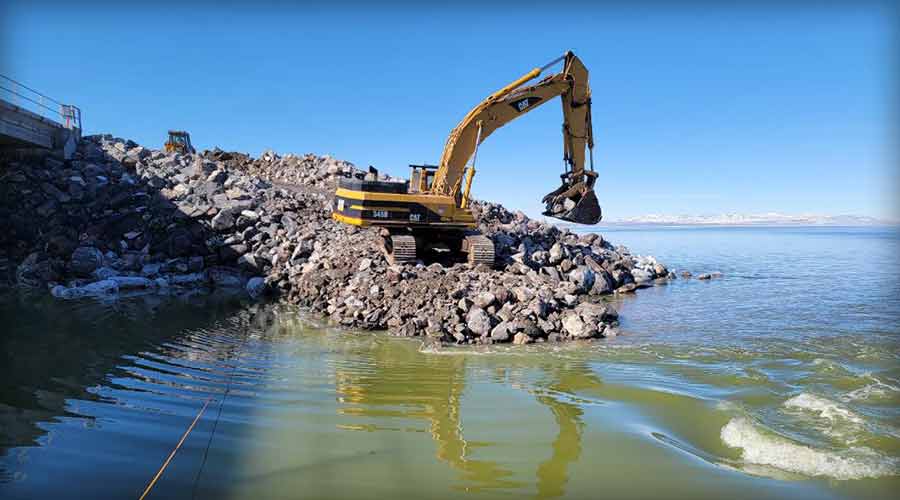By Julie Sneider, Senior Associate Editor
In February, Utah Gov. Spencer Cox issued an executive order calling for the Great Salt Lake causeway berm to be raised to help increase the water level of the southern half of the drought-stricken lake.
Owned by Union Pacific Railroad, the causeway is a raised rock-filled rail track that stretches 20 miles across the lake, separating it in two and limiting water flow between the lake’s north and south “arms.” Raising the berm would increase the water level in the lake’s south arm by capturing spring runoff from the winter’s record snowpack as it melted.
The governor directed the Utah Division of Forestry, Fire and State Lands to raise the berm by about 5 feet. Managed by the state, Great Salt Lake reached a historically low surface level elevation of 4,188 feet in early November 2022. The low lake levels are causing a significant increase in salinity, which threatens the lake’s ecosystem, according to state officials.
The state lands division controls the water flow. Raising the berm’s height increased the flow of water and helped decrease salinity in the south arm.
“The Great Salt Lake is crucial to our environment, ecology and economy, and we must do everything we can to protect it,” Cox said in a press release announcing his executive order.
In particular, the lake helps support the state’s brine shrimp harvest, valued at $10 million to $60 million. As of 2023, 21 companies harvest brine shrimp from the lake, according to the Utah Division of Wildlife Resources. Additionally, more than 10 million migratory birds fly into the area annually to feed off the brine flies and brine shrimp.
 “Union Pacific is sensitive to the environmental issues and the fragile nature of the ecosystem.” — Nathan Anderson, UP Union Pacific Railroad
“Union Pacific is sensitive to the environmental issues and the fragile nature of the ecosystem.” — Nathan Anderson, UP Union Pacific Railroad UP was "honored" to assist the state agencies on the berm-raising project, says Nathan Anderson, UP’s senior director of public affairs in the Rocky Mountain states.
“When the [governor’s] call went out we saw the opportunity to be a good neighbor. We have the skills, the materials and the tools to do a project like this,” he says.
UP has a seven-member team whose entire job is to manage the causeway.
“They understand the lake, the ecosystem and how the causeway functions,” says Anderson. “They’re able to do the causeway track maintenance and management as it needs to happen.”
UP owns a quarry about a mile from the causeway, where it mined and then transported material (which it donated) and personnel to the project. The Class I coordinated the track time and right-of-way access to enable the project to be completed with little impact on freight traffic.
Anderson compared the UP right-of-way team to a group of landscapers.
“They know where to put the rocks and material to address issues like stability that are so important for the safe, efficient operation of our rail network,” he says. “But they also understand how the lake is going to ebb and flow, and how to address potential erosion issues.”
UP has a long history with the lake. The Lucin Cutoff rail line opened to rail traffic in 1903 to replace the original Union Pacific-Central Pacific tracks completed through Promontory in 1869. The line shortened the journey from Lucin to Ogden by more than 40 miles and shaved hours off the railroad's schedule, according to a Salt Lake Tribune article published in 2016.
A wood trestle for train traffic was built across the lake until Southern Pacific Railroad built the causeway along with two culverts in 1959. The culverts allowed water to circulate between the lake’s north and south arms. UP took ownership of the causeway when it merged with Southern Pacific in 1996.
Eventually, the aging culverts began to collapse, and in 2011, UP began filling them in to protect the causeway’s infrastructure. In 2016, UP opened a breach — traversed by a bridge — to replace the culverts and allow the water to continue to circulate.
Meanwhile, the lake has continued to dry up, causing long-term concerns about its ecological future. That's why when this winter’s record snowfall began to melt, state officials jumped at the opportunity to help shore up lake levels.
“Union Pacific is sensitive to the environmental issues and the fragile nature of the ecosystem,” says Anderson. “We’re pleased to be a good neighbor and partner with the state and other stakeholders to identify the unique needs of that ecosystem and make sure we’re doing our part to maintain the health of the lake.”

